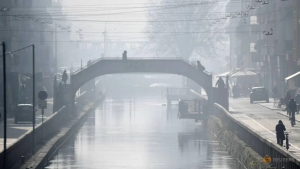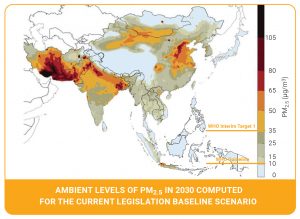Andrei Marti
Since 2008 the urban population outnumbered the rural population, therefore the majority of people live in urban areas. 90% of them do not breath air that meets the quality suggested by the WHO.1 It is an issue in Switzerland too. In some cities the concentration of PM2.5, NOx and Ozon are elevated.2

Figure 75.1 – Smog levels are extremely high in northern Italy. This picture shows fog and smog on the Naviglio Pavese canal in Milan. (Photo: Reuters/Flavio Lo Scalzo)
Concentrations are too high
Even as awareness for polluted air rises globally, many urban areas are not improving. In Europe the air-quality is getting better, but not as fast as expected. Around 77% of the urban EU-28 population in 2017 live in areas with exceeded PM2.5. Ground-near ozon-levels are even worse: 96% of the EU28 urban population was exposed to levels exceeding the WHO values for safe air.3
If we have a look at Asia, the issue is more severe. An estimated 4 Billion people – 90% of the whole population – will be exposed to air pollution that imposes significant health risks, sometimes several times higher than the WHO guideline.4

Figure 75.2 – Source: ccacoalition.org
The main sources of anthropogenic air-pollutants are transport, households, industrial processes, agriculture and waste treatment.3 Unluckily, these pollutants are increasing in numbers as wealth increases and therefore accelerate the growth of emissions in Asia and other developing countries. It’s important to mention that air pollutants, especially the particulate matters (PM), can also have a natural origin – like pollen, sea-salt or desert sands – with similar implications. However, the anthropogenic pollutants are then added on top of that, further increasing the stress.
What air-pollution does to us
The health-impacts on humans with exaggerated long-term exposures are shocking. An estimated 500’000 people in Europe prematurely per year due to O3, NO2 and PM.3 Of course, death is the most severe consequence, but other health-related symptoms are headache, stress and anxiety, infections in the whole breathing apparatus, several forms of cancers and cardiovascular diseases. PMs can even implicate Fertility and the nervous system.5 This leads to increased medical expenses and raised medical costs and affects the economy too since more people are getting sick.
Ecosystems are also negatively affected by air pollutants, most significantly by ozone, ammonia and nitrogen oxides. These substances are harmful to vegetation and fauna directly, but also change the environment by affecting soils and waterbodies. The degradation of ecosystems and their services also extend to the economy and health. The agriculture for example has lower crop and forest yields. Also, the built infrastructure is affected by air-pollutants. Many materials are reacting chemically with the substances in the air which causes buildings and cultural heritage sites to wither faster.3
In addition, socio-demographic factors are relevant regarding the effects of pollution. Usually people with lower incomes are exposed to way higher concentrations of air pollutants, even in their own homes. Therefore, we deal with a form of social inequality. Furthermore, the youngest and elder parts of society are more vulnerable and need better protection.
What can we do about it?
There are promising solutions in abundance for all emitting sectors. Most solutions imply energy efficiency or the spread of cleaner technology and public regulations on emissions. However, what can one person do?
We can help improving the situation in various ways: we can use public transportation or alternative, sustainable ways of going from A to B. We can learn about renewable energy and supply our personal energy-demand with renewables, we might even reduce our demand by using energy-efficient devices or simply by saving energy. We can try to decrease waste, separate waste and recycle as much as possible. And most important, we can speak through our money – buy products from enterprises that try to reduce their impact on air-quality. To sum up, we must just avoid as many unclean burnings of any kind as possible.3 4
A good message: By solving the issue of air-pollution, we co-benefit in solving other global issues such as climate change, food security, water safety and the loss of biodiversity. We see that it’s worth tackling air-pollution for so many reasons. Let’s take a deep breath and get the job done.
References and further readings:
1 https://sustainabledevelopment.un.org/topics/sustainablecities (visited: 20.3.2020)
2 Nationales Beobachtungsnetz für Luftfremdstoffe NABEL, BAFU, 2019
3 Air quality in Europe – EEA Report No 10/2019, doi:10.2800/822355
4 Air Pollution in Asia and the Pacific: Science-based solutions, CCAC, UNEP & Asia Pacific Clean Air Partnership, 2019, https://www.ccacoalition.org/en/content/air-pollution-measures-asia-and-pacific
5 https://www.eea.europa.eu/signals/signals-2013/infographics/health-impacts-of-air-pollution (visited: 20.3.2020)
Media Attributions
- fog and smog in milan
- PM2.5 in Asia